
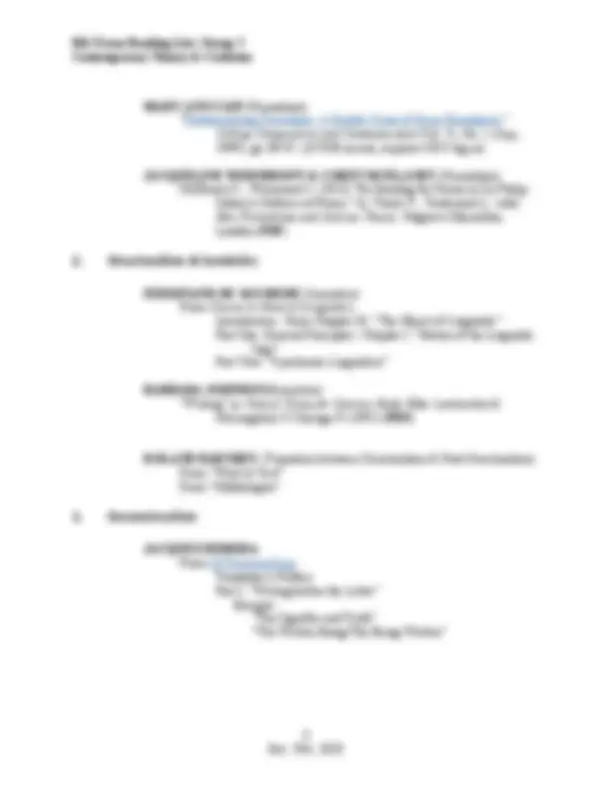
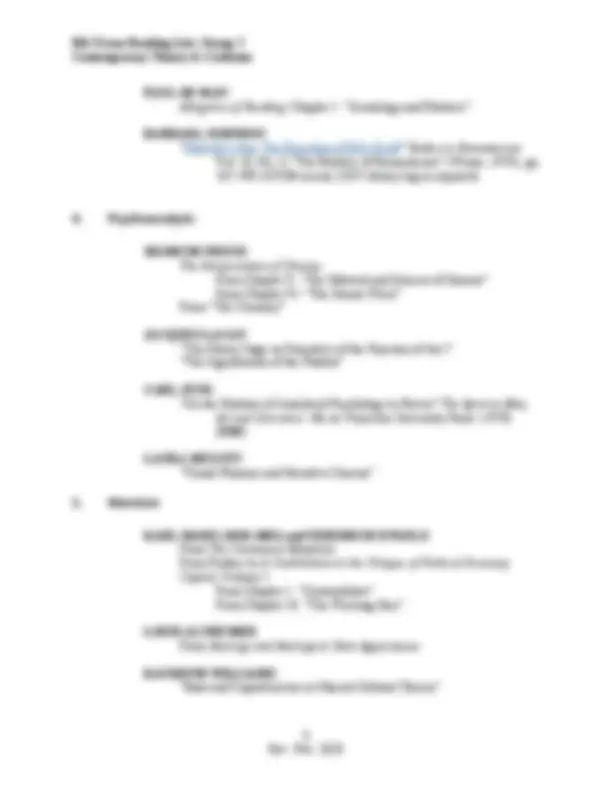
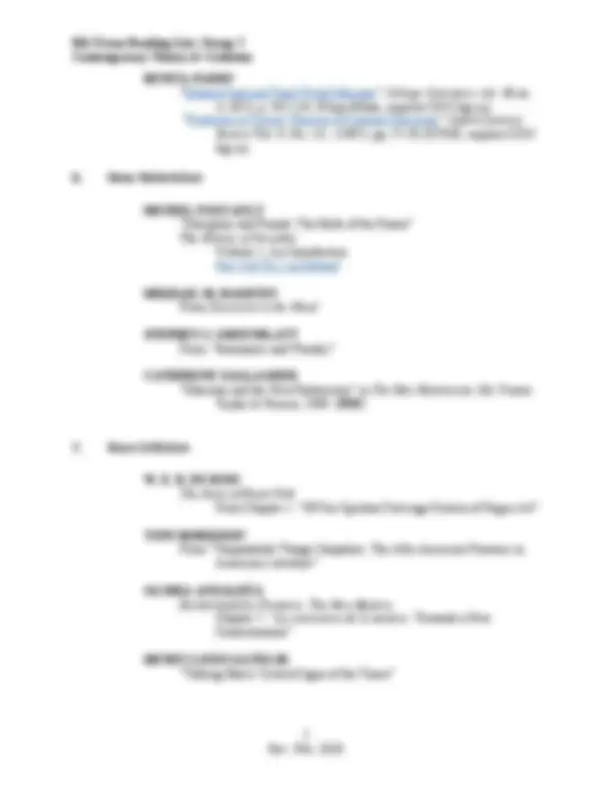
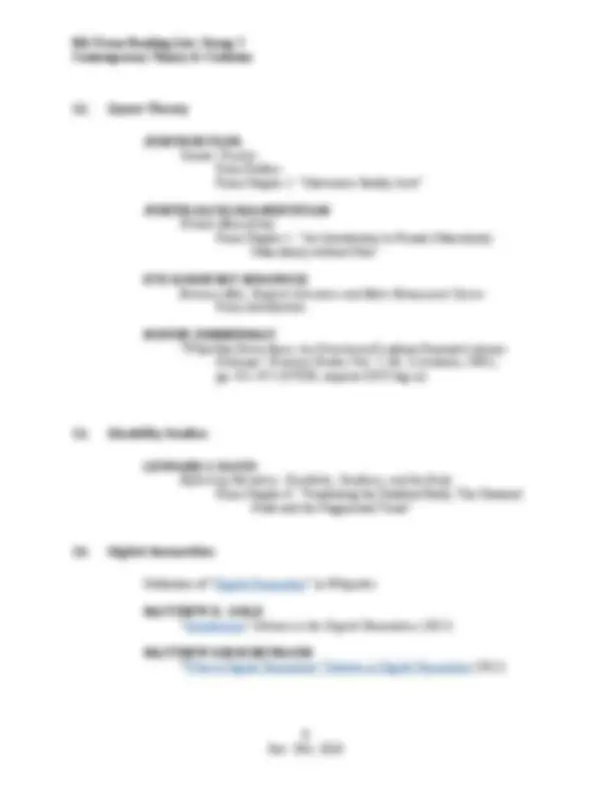
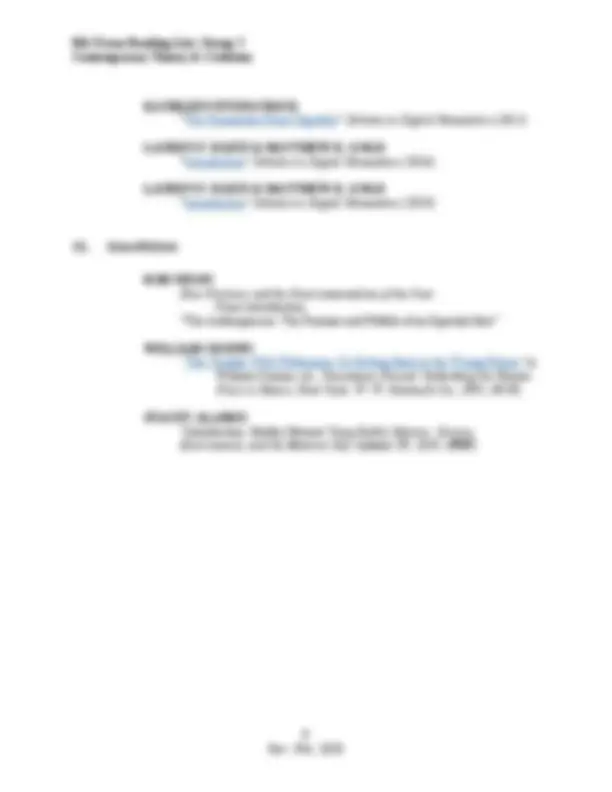
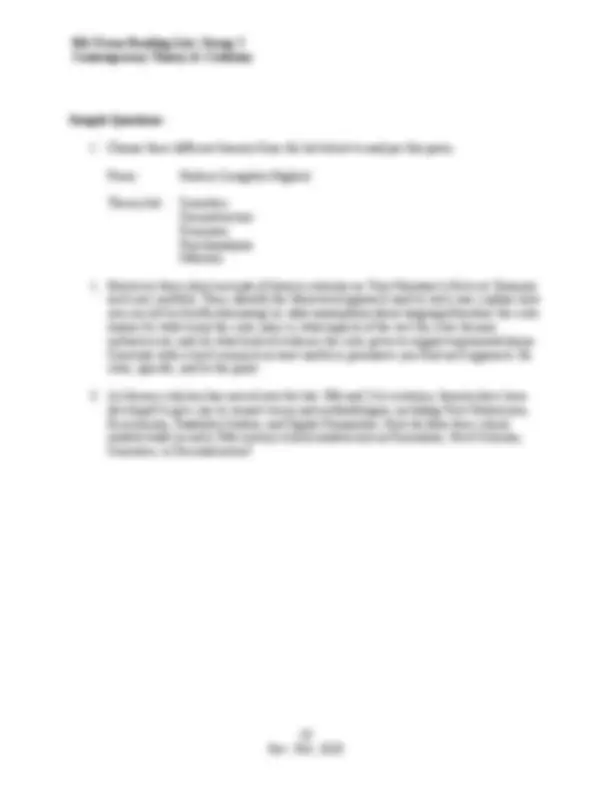


Study with the several resources on Docsity

Earn points by helping other students or get them with a premium plan


Prepare for your exams
Study with the several resources on Docsity

Earn points to download
Earn points by helping other students or get them with a premium plan
Community
Ask the community for help and clear up your study doubts
Discover the best universities in your country according to Docsity users
Free resources
Download our free guides on studying techniques, anxiety management strategies, and thesis advice from Docsity tutors
A reading list for the SJSU MA Exam in Contemporary Literary Theory and Criticism. The list includes foundational texts from Classical and Romantic periods, as well as contemporary Western theory and criticism. The readings are provided as excerpts in The Norton Anthology of Theory and Criticism, and additional material is provided as links or pdfs in a password-protected area. The list also includes a guide that illustrates how each theoretical model can be applied to analyze and interpret literary works.
Typology: Summaries
1 / 10

This page cannot be seen from the preview
Don't miss anything!







Dept. of English & Comparative Literature, SJSU MA Exam Reading List: Group 3
The field of literary theory and criticism is vast and encompasses many different classical and modern literary traditions across the world. The MA exam, however, focuses primarily on contemporary Western theory and criticism. This reading list is therefore intended to provide a broad understanding of the major models of contemporary theory and criticism through a selection of representative authors/texts. By way of providing a historical background and context to these contemporary theories, the reading list includes a small selection of foundational texts/authors from the Classical and Romantic periods. In addition, the list incorporates a guide that illustrates how each theoretical model can be applied to analyze and interpret literary works.
For a concise historical overview of each critical model, see Johns Hopkins Database of Criticism and Theory (SJSU library log-in required)
PLATO (ca. 427–ca. 347 B.C.E.) From Phaedrus, Ion, & Book VII & X of The Republic ARISTOTLE (384–322 B.C.E.) From Poetics
Contemporary Theory & Criticism 2
“Introductory Discourse” to Plays on the Passions ANNA BARBAULD (1743-1825) “On the Pleasure Derived from Objects of Terror” (on Internet Archive or Project Gutenberg) EDMUND BURKE (1729-1797) A Philosophical Enquiry into the Origin of Our Ideas of the Sublime and Beautiful From Part I. Sections I-VIII From Part III. Section XXVII SAMUEL TAYLOR COLERIDGE (1772-1834) From Biographia Literaria Vol. 1 - From Chps. 1, 4, 13 Vol. 2 - From Chp. 14 WILLIAM WORDSWORTH (1770–1850) Preface to Lyrical Ballads, with Pastoral and Other Poems (1802) PERCY BYSSHE SHELLEY (1792-1822) From A Defence of Poetry
T. S. ELIOT (New Criticism) “Tradition and the Individual Talent” MINDA RAE AMIRAN (New Criticism) “Some Paradoxes of New Criticism” (2013) in The New Criticism: Formalist Literary Theory in America , Cambridge (3-26) ( PDF) CLEANTH BROOKS (Formalism) The Well Wrought Urn: Chapter 11. “The Heresy of Paraphrase”
Contemporary Theory & Criticism 4
Allegories of Reading : Chapter 1: “Semiology and Rhetoric” BARBARA JOHNSON “Melville’s Fist: The Execution of Billy Budd ” Studies in Romanticism Vol. 18, No. 4, “The Rhetoric of Romanticism” (Winter, 1979), pp. 567 - 599 (JSTOR access; SJSU library log-in required)
The Interpretation of Dreams From Chapter V. “The Material and Sources of Dreams” From Chapter VI. “The Dream-Work” From “The Uncanny” JACQUES LACAN “The Mirror Stage as Formative of the Function of the I” “The Signification of the Phallus” CARL JUNG “On the Relation of Analytical Psychology to Poetry” The Spirit in Man, Art and Literature. 4th ed. Princeton University Press. (1978) ( PDF ) LAURA MULVEY “Visual Pleasure and Narrative Cinema”
KARL MARX (1818-1883) and FRIEDRICH ENGELS From The Communist Manifesto From Preface to A Contribution to the Critique of Political Economy Capital , Volume 1 From Chapter 1. “Commodities” From Chapter 10. “The Working-Day” LOUIS ALTHUSSER From Ideology and Ideological State Apparatuses RAYMOND WILLIAMS “Base and Superstructure in Marxist Cultural Theory”
Contemporary Theory & Criticism 5
“Edward Said and Third World Marxism” College Literature , vol. 40 no. 4, 2013, p. 105-126. (ProjectMuse; requires SJSU log-in) “Problems in Current Theories of Colonial Discourse” Oxford Literary Review Vol. 9, No. 1/2, (1987), pp. 27-58 (JSTOR; requires SJSU log-in)
“Discipline and Punish: The Birth of the Prison” The History of Sexuality Volume 1, An Introduction Part 4 of Ch 2 on Method MIKHAIL M. BAKHTIN From Discourse in the Novel STEPHEN J. GREENBLATT From “ Resonance and Wonder” CATHERINE GALLAGHER “Marxism and the New Historicism” in The New Historicism. Ed. Veeser. Taylor & Francis, 1989. ( PDF )
The Souls of Black Folk From Chapter 1. “Of Our Spiritual Strivings Criteria of Negro Art” TONI MORRISON From “Unspeakable Things Unspoken: The Afro-American Presence in American Literature” GLORIA ANZALDÚA Borderlands/La Frontera: The New Mestiza Chapter 7. “ La conciencia de la mestiza: Towards a New Consciousness” HENRY LOUIS GATES JR. “Talking Black: Critical Signs of the Times”
Contemporary Theory & Criticism 7
“The Laugh of the Medusa” JULIA KRISTEVA Revolution in Poetic Language From Part 1. “The Semiotic and the Symbolic”
“Defining the Postmodern” FREDRIC JAMESON “Postmodernism and Consumer Society” BELL HOOKS “Postmodern Blackness”
“Interaction between Text and Reader” LOUISE ROSENBLATT “Evoking a Poem” in The Reader, the Text, The Poem: The Transactional Theory of Literary Work. Southern Illinois University Press, 1994. 48 - 70 ( PDF ) JANE TOMPKINS “The Reader in History” in Reader-response Criticism: From Formalism To Post-structuralism. Johns Hopkins UP, 1980. 201-232. ( PDF) STANLEY FISH Is there a Text in This Class? The Authority of Interpretive Communities Chapter 14. “How to Recognize a Poem When You See One”
Contemporary Theory & Criticism 8
Gender Trouble From Preface From Chapter 2. “Subversive Bodily Acts” JUDITH (JACK) HALBERTSTAM Female Masculinity From Chapter 1. “An Introduction to Female Masculinity: Masculinity without Men” EVE KOSOFSKY SEDGWICK Between Men: English Literature and Male Homosocial Desire From Introduction BONNIE ZIMMERMAN “What Has Never Been: An Overview of Lesbian Feminist Literary Criticism” Feminist Studies Vol. 7, No. 3 (Autumn, 1981), pp. 451-475 (JSTOR; requires SJSU log-in)
Enforcing Normalcy: Disability, Deafness, and the Body From Chapter 6. “Visualizing the Disabled Body: The Classical Nude and the Fragmented Torso”
Definition of “Digital Humanities” in Wikipedia MATTHEW K. GOLD “Introduction” Debates in the Digital Humanities (2012) MATTHEW KIRSCHENBAUM “What is Digital Humanities” Debates in Digital Humanities (2012)
Contemporary Theory & Criticism 10 Sample Questions: